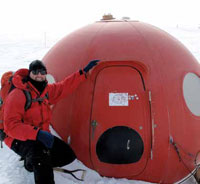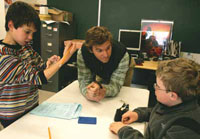

CIRES travels to the ends of the Earth with middle school science teacher Ian Schwartz. Schwartz, who teaches Earth science at Casey Middle School in Boulder, Colorado, joined three graduate student Fellows from the University of Colorado at Boulder in November 2009 to conduct research at the Dry Valleys field site in Antarctica. Education and Outreach sits down with Schwartz to talk about his experience and find out how extreme science in Antarctica energizes classroom science back home.
What was the highlight of conducting research in Antarctica?
Not only doing a piece of research that is related to the longterm study, but also having the opportunity to participate in other research going on there and seeing how it fits into the larger project to answer one big common goal. As a middle-level teacher, I spend a lot of time teaching big ideas, and it was great to process it in a way where you are looking at how all the little pieces fit together.
Did you have any big “Aha!” moments about how science is done?
Beyond the science we were there to do, there’s a real logistical component of doing science in Antarctica that’s fascinating to me. You don’t have available what you might need all the time. Science is a way of thinking, and you need to think through and problem-solve just to do the research you went there to conduct.
What will you bring back to the classroom after this experience?
As teachers, we have more competition than ever for kids’ attention in school. Unless things are relevant, kids aren’t listening. I can draw upon my experiences in Antarctica to make learning more relevant. For example, yesterday we talked about the seasons and how it’s light all the time in Antarctica now. I can show my students pictures of us doing research at midnight when it’s still bright outside to illustrate the point I made yesterday. This brings science alive.![]()

Graduate student Phillip Taylor talks with 5th graders in Erin Shea-Bower’s class. “Phil set up some amazing indoor/outdoor laboratory-like explorations, “ Shea-Bower said.
Fellow Michelle Ochomogo feels that being a Latina in the classroom allows her to connect with Latino students and answer questions about why she went to college, and what college is like. She and her colleagues have designed a series of campus visits to hear about the Fellows’ research and see their labs. “The students get to interact with college students and professors to see that it’s not a scary place and the campus has all types of people,” said Ochomogo.
Hopefully, these tours pave the way for these students, some of whom will be the first in their family to graduate from high school. “These Fellows are able to offer these kids some of the finest science materials, experts, knowledge, and experience around,” said Shea-Bower. “It’s not every day that a group of fifth graders gets to work with a pre-Ph.D. candidate who was just published in Nature. Not every day at all.” ![]()
about about teacher education and K-12 classroom resources through CIRES Education Outreach
When ecological and evolutionary biology graduate student Phillip Taylor applied for a fellowship with Project Extremes, he wanted to communicate science better and improve young people’s science literacy. “The ability to tune a science message on the fly to each of the audiences is a skill that I could only have learned by being involved in the National Science Foundation program,” said Taylor.
Project Extremes (EXploration, Teaching and Research for Excellence in Middle and Elementary Science), funded by the NSF through GK-12 (grades K-12) Program, is a partnership between the CIRES, several departments of the University of Colorado at Boulder, and the Boulder Valley School District (BVSD). The focus is to place Science, Technology, Engineering, and Math (STEM) graduate students into BVSD’s more socioeconomically diverse schools, enriching science education for students and the professional development of young scientists, called “Fellows.”
Teachers and students gain valuable insight into the subject and process of science. “The kids are always thrilled to have ‘Phil, our science guy’ in class,” said fifth-grade teacher, Erin Shea-Bower. “As a general rule, elementary students do not have access to labs, but Phil set up some amazing indoor/outdoor laboratory-like explorations, complete with dissecting microscopes and pond samples.”
Taylor has also been an excellent resource for Shea-Bower. “I am learning in far greater depth about some of the topics that I have been teaching for a while. The more knowledge I have, the more excited I am to teach a particular topic,” she said. “It’s been terrific.”




